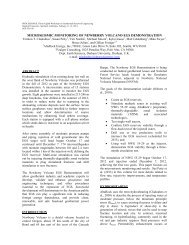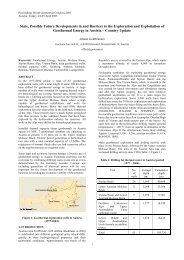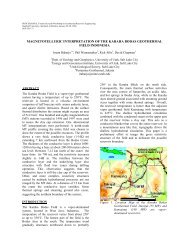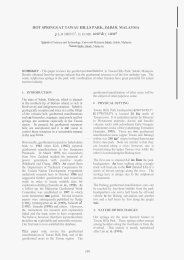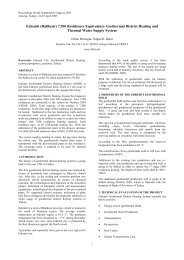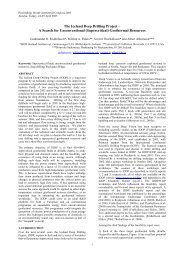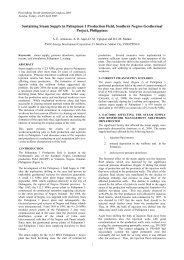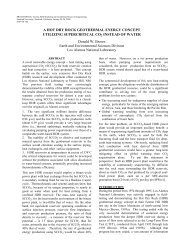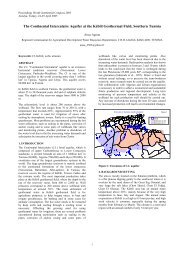Updated Hydrogeological Model of the Bacon-Manito Geothermal ...
Updated Hydrogeological Model of the Bacon-Manito Geothermal ...
Updated Hydrogeological Model of the Bacon-Manito Geothermal ...
Create successful ePaper yourself
Turn your PDF publications into a flip-book with our unique Google optimized e-Paper software.
Figure 2. Sectoral map <strong>of</strong> Bacman showing <strong>the</strong><br />
Palayang Bayan, Botong, Cawayan,<br />
Tanawon and Rangas sectors and location<br />
<strong>of</strong> cross sections. The colors represent<br />
<strong>the</strong> various rock units <strong>of</strong> GSF.<br />
SUBSURFACE STRATIGRAPHY<br />
BGF is underlain by andesitic lavas, tuffs and<br />
breccias <strong>of</strong> <strong>the</strong> Late Pliocene-Late Pleistocene Pocdol<br />
Volcanics (PV) and by carbonate-clastic sediments <strong>of</strong><br />
<strong>the</strong> Late Miocene-Early Pliocene Gayong<br />
Sedimentary Formation (GSF) (Ramos, 2002).<br />
Pocdol Volcanics<br />
PV is characterized by two-pyroxene andesite and<br />
basaltic lava flows, andesitic tuff breccias, tuffs and<br />
basaltic breccias (Figures 2 –4). The breccia clasts,<br />
commonly composed <strong>of</strong> andesite, basalt, scoria and<br />
those derived from older terrains <strong>of</strong> microdiorite and<br />
dacite, are held toge<strong>the</strong>r in a tuffaceous matrix <strong>of</strong><br />
broken plagioclase or clinopyroxene crystals. This<br />
formation has an approximate maximum thickness <strong>of</strong><br />
2,000 m. It is assigned a Plio-Pleistocene age and<br />
reflects <strong>the</strong> extensive volcanism during this period.<br />
The basal unit <strong>of</strong> Pocdol Volcanics is usually <strong>the</strong><br />
water-lain andesitic lava flows or hyaloclastite.<br />
Old soil beds or lenses called paleosols are made up<br />
<strong>of</strong> hematized and argillized rocks with a general<br />
thickness <strong>of</strong> about 20 m. These are common at <strong>the</strong><br />
basal unit <strong>of</strong> PV near or at <strong>the</strong> PV-GSF contact and<br />
serve as <strong>the</strong> marker horizon for <strong>the</strong>ir stratigraphic<br />
boundaries in most <strong>of</strong> <strong>the</strong> Bacman wells. There are<br />
cases, however, when <strong>the</strong> PV-GSF contacts appear to<br />
be transitional. In Botong and Tanawon, this is<br />
shown as an intercalation <strong>of</strong> hyaloclastite with <strong>the</strong><br />
sediments or <strong>the</strong> partial calcareous cementation in <strong>the</strong><br />
sedimentary breccias. The paleosol horizon thus<br />
signifies a regressive stage and end <strong>of</strong> marine<br />
sedimentation in this part <strong>of</strong> <strong>the</strong> Bicol Basin during<br />
<strong>the</strong> Early Pliocene, and onset <strong>of</strong> aerial, subaerial to<br />
partly sub-aqueous depositional conditions for PV.<br />
Gayong Sedimentary Formation<br />
GSF is predominantly composed <strong>of</strong> carbonaceous<br />
and fossiliferous limestones, reefal carbonates,<br />
calcareous sedimentary breccias and fine-grained<br />
clastic rocks (Figures 2-4). In Botong, fossiliferous<br />
calcarenites show echinoid spines, red algae and<br />
larger foraminifera. In addition, andesitic clasts with<br />
occasional basalt admixed with bioclasts <strong>of</strong> coral,<br />
algae, shells and foraminifera are all cemented by<br />
calcite. On <strong>the</strong> o<strong>the</strong>r hand, a recent core in Palayang<br />
consists <strong>of</strong> a clast-supported volcanic sandstone. Its<br />
age, based on paleoanalysis <strong>of</strong> core samples ranges<br />
from Late Miocene to Early Pliocene (N18-21<br />
undifferentiated) coincides with widespread<br />
deposition <strong>of</strong> carbonates in <strong>the</strong> shallow neritic to<br />
open marine setting <strong>of</strong> <strong>the</strong> Bicol basin. Lith<strong>of</strong>acies<br />
characterization indicates a paleoenvironment<br />
gradation – from shallow neritic to shallow open<br />
marine - in Botong and Palayang Bayan sectors, and<br />
deepening towards <strong>the</strong> south in Tanawon, possibly<br />
reaching <strong>the</strong> abyssal plains <strong>of</strong> deep marine setting<br />
(Figure 4). Observed lateral and vertical changes in<br />
lith<strong>of</strong>acies <strong>of</strong> GSF are attributed to natural deepening<br />
<strong>of</strong> ocean basin morphology, historical sea level<br />
fluctuations, and tectonic activities (Santos and<br />
Dimabayao, 2011).<br />
This sedimentary formation has widespread<br />
occurrence in Bacman except in Cawayan sector<br />
where this unit was not observed within <strong>the</strong> sampled<br />
intervals <strong>of</strong> <strong>the</strong> wells. Most <strong>of</strong> <strong>the</strong> production wells<br />
were blind drilled at shallow levels but a core cut at<br />
deeper levels showed an intensely altered volcanic<br />
rock belonging to PV. A reinjection well drilled<br />
towards <strong>the</strong> west likewise intersected tuff breccias<br />
and andesitic hyaloclastite <strong>of</strong> Pocdol Volcanics.<br />
CAWAYAN INTRUSIVE COMPLEX<br />
Both rock units are intruded by multi-lithologic dikes<br />
ranging in composition from gabbro, monzogabbro,<br />
monzodiorite, pyroxene to quartz microdiorite and<br />
diabase and microdiorite, andesite and diabase<br />
collectively called <strong>the</strong> Cawayan Intrusive Complex<br />
(CIC) (Figures 3-4). Their compositional and<br />
textural variations may be an indication <strong>of</strong> <strong>the</strong>ir<br />
emplacement in various stages <strong>of</strong> magmatic<br />
differentiation and rejuvenation. K-Ar radiometric<br />
dating gave an Early Pleistocene age (1.71 Ma) for<br />
<strong>the</strong> outcropping Rangas Intrusive and a comparable<br />
age (1.79 Ma) for a core sample from a Cawayan<br />
well. These ages possibly represent <strong>the</strong> older<br />
intrusive event. Most Bacman wells intersected <strong>the</strong><br />
CIC, where local contact metamorphic aureoles<br />
develop along <strong>the</strong> margins <strong>of</strong> <strong>the</strong>se dikes. These<br />
hornfels display a distinct sugary texture and consists<br />
<strong>of</strong> various suites usually reflecting <strong>the</strong> composition <strong>of</strong><br />
<strong>the</strong> original country rock. The garnet-amphibole-



